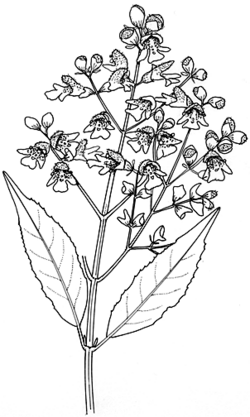Common name: Victorian christmas bush
Prostanthera lasianthos Labill. APNI* Synonyms: Prostanthera lasianthos var. subcoriacea F.Muell. ex Benth. APNI*
Prostanthera lasianthos Labill. variant 'subcoriacea' APNI*
Prostanthera lasianthos var. Typical variant Labill. APNI*

Description: Shrub to small tree, usually 1–6 m high, aromatic; branches glabrous or sparsely covered with short, curled hairs and ± sessile glands.
Leaves with lamina ovate or rarely ± narrow-ovate, usually 40–120 mm long, 10–32 mm wide, apex acute to acuminate; base cuneate to shortly attenuate, slightly oblique; margins usually ± toothed; upper surface dark green, lower surface paler, glabrous; petiole 6–10 mm long.
Flowers in a terminal botryoid, branched-botryoid or panicle; bracteoles persistent, 2–4 mm long. Calyx 4–5 mm long; tube 2–3 mm long; upper lobe 1.5–3 mm long, enlarged in fruit. Corolla 10–15 mm long, white to pale mauve with purple spots in throat. Anthers with appendage c. 1.5 mm long.
Flowering: November–March
Distribution and occurrence: Grows in rainforest, sclerophyll forest, and subalpine woodland, mainly along watercourses and in moist gullies.
NSW subdivisions: SC, NT, CT, ST
Other Australian states: Vic. Tas.
This species is morphologically variable, and a number of informal variants can be recognized. Populations growing at higher altitudes, particularly on exposed sites, tend to have reduced leaf size and/or number of teeth on leaf margin.
Text by B. J. Conn
Taxon concept: B.J. Conn, in G.J. Harden (ed.) (1992)
| | Key to the informal variants | |
| 1 | Leaves with petiole usually 4–8 mm long and lamina narrow-ovate to narrow-elliptic, mostly 60–95 mm long, 20–30 mm wide (length to breadth ratio 3.1–4.5), margins usually distinctly toothed. Inflorescence variable, but tends to be elaborated. Usually a small to medium-sized tree, sometimes a shrub | Typical variant |
| 2 | Leaves short with petiole usually 3–6 mm long; lamina narrow-ovate to ovate, 30–46 mm long, 12–20 mm wide (length to breadth ratio 2.3–2.7), margins distinctly toothed. Inflorescence as for typical variant. Medium-sized compact shrub | var. subcoriacea |
| 3 | Leaves narrow with petiole 3–6 mm long; lamina lanceolate, usually 42–55 mm long, 7–10 mm wide (length to breadth ratio 5.2–6), with margin entire or toothed (in Bindook Creek and Wombeyan Caves area). Inflorescence as for typical variant, but usually less elaborated. | Rheophytic variant |
| 4 | Leaves as for typical variant with petiole usually 5–8 mm long; lamina narrow-ovate, 68–95 mm long, 16–29 mm wide (length to breadth ratio 2.8–4.7), however, with margins entire or occasionally with a few minute teeth. Inflorescence as for typical variant, however, usually less elaborated. | New England smooth-leaved variant |
| 5 | Appears to be intermediate between the typical and the 'var. subcoriacea' variants. The leaves are similar to those of the typical variant, except that they are shorter (similar to the 'var. subcoriacea' variant) and narrower (similar to plants from the Nandewar Ra. populations), petiole 5–10 mm long and lamina 29–46 mm long and 8–12 mm wide with length to breadth ratio 3.6–4.4. An erect open shrub 2–3 m high. | Girraween/Polblue variant |
APNI* Provides a link to the Australian Plant Name Index (hosted by the Australian National Botanic Gardens) for comprehensive bibliographic data
***The AVH map option provides a detailed interactive Australia wide distribution map drawn from collections held by all major Australian herbaria participating in the Australian Virtual Herbarium project.
|


